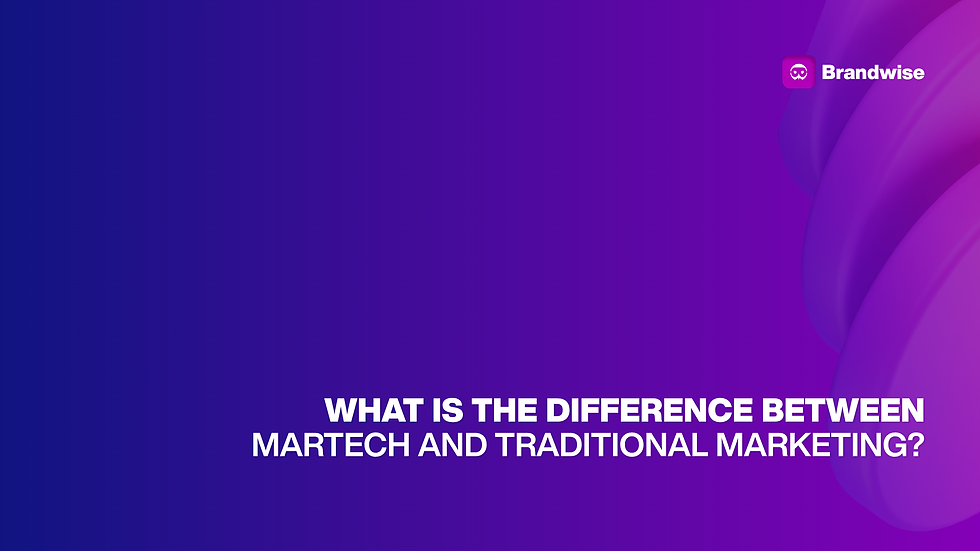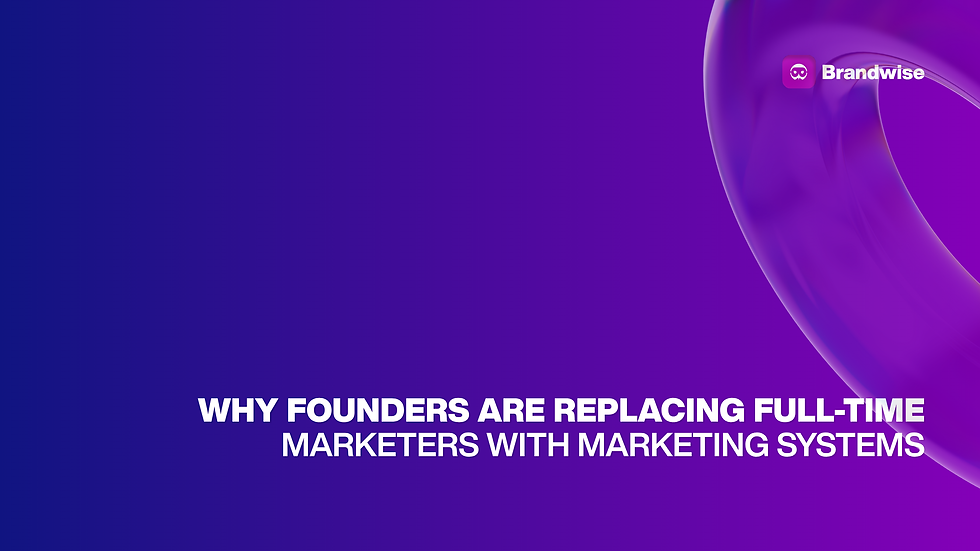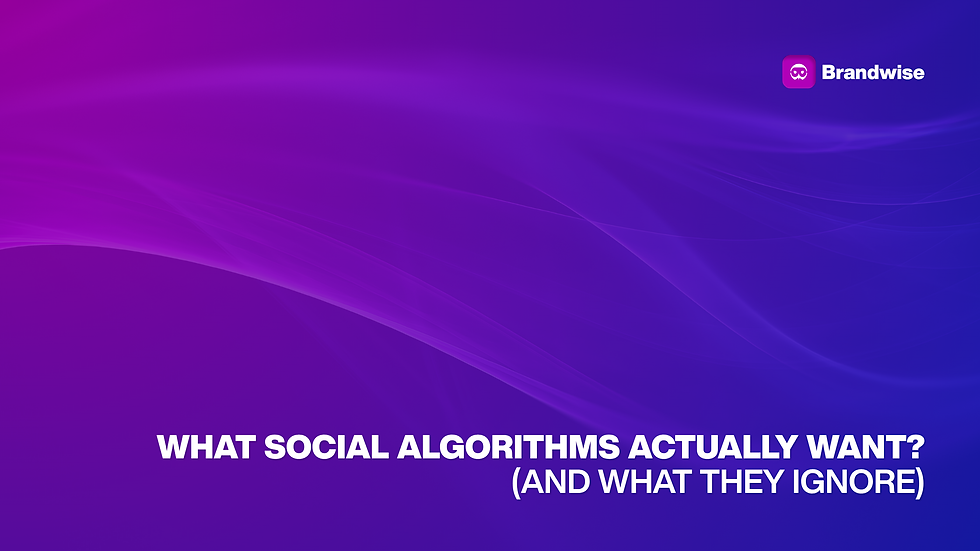What is the Difference Between Martech and Traditional Marketing?
- Brand Wise

- Jul 18
- 7 min read

Marketing has come a long way from glossy magazine spreads and flashy billboards. Today, businesses are moving fast, customers expect instant responses, and every click can be tracked.
Traditional marketing, while still recognizable, struggles to keep up in a world driven by data, personalization, and digital-first experiences. That’s where MarTech comes in—not as a buzzword, but as the core of how modern marketing actually works.
The difference between traditional marketing and MarTech isn’t just about channels—it’s about mindset. One relies on repetition and reach; the other is built around automation, analytics, and precision. Table of Contents
Defining the Two Worlds
What Is Traditional Marketing?
Traditional marketing includes all the classic, offline methods—TV commercials, radio jingles, newspaper spreads, magazine ads, billboards, brochures, cold calls, and even in-store signage. These approaches aim to push a message out to a wide audience, hoping it sticks with a small percentage.
It’s a one-size-fits-all tactic built around reach and repetition, not relevance. And while it still has a place in some brand awareness campaigns, it’s expensive, hard to measure, and painfully slow to adjust if something isn’t working.
The biggest limitation? Feedback loops are either delayed or nonexistent. You might spend thousands on a print campaign and still not know how many people actually saw it, let alone who took action. It’s high risk, high cost, and low precision.
What Is MarTech?
MarTech—short for marketing technology—is the toolbox modern marketers use to run smarter, faster, and more personalized campaigns. It includes tools like CRMs, email marketing platforms, automation software, analytics dashboards, SEO tools, social media schedulers, and more. These aren’t just disconnected apps—they form a connected ecosystem where data moves in real time, campaigns respond to behavior, and decisions are backed by actual insights.
Unlike traditional marketing, MarTech isn’t about pushing one message to the masses—it’s about creating targeted experiences at scale. You’re not guessing if someone saw your ad—you’re tracking clicks, opens, conversions, and engagement across every touchpoint. And the best part? You can optimize as you go. Change the creative, shift the budget, test messaging—all in real time, without waiting for next month’s print deadline.
10 Key Differences Between MarTech and Traditional Marketing
The gap between traditional marketing and MarTech isn’t just about where your ads appear—it’s about how each approach helps (or holds back) your ability to grow, adapt, and connect meaningfully with your audience. Here's a side-by-side breakdown that highlights just how much the game has changed. 1. Medium of Communication
Traditional: Relies on offline channels—TV, radio, newspapers, flyers, billboards.
MarTech: Operates entirely through digital channels like websites, email, social media, paid search, and automation platforms.
Traditional marketing puts your message into the world and hopes people see it. MarTech ensures your message lands in the right place, at the right moment, with precision.
2. Targeting Capabilities
Traditional: Targets a general audience with broad, static campaigns.
MarTech: Offers laser-focused targeting based on demographics, interests, browsing history, device usage, and even time of day.
You're not wasting your time trying to reach “everyone.” You're focused on the people most likely to care and convert.
3. Personalization
Traditional: Delivers the same message to everyone, regardless of who’s on the receiving end.
MarTech: Delivers personalized experiences based on user data, actions, and lifecycle stages.
From personalized subject lines to dynamic landing pages, MarTech creates one-to-one marketing at scale.
4. Measurability
Traditional: Difficult to track. You might know how many people read the newspaper, but not who acted.
MarTech: Every click, scroll, bounce, and conversion is tracked in real time.
You get clarity, not assumptions. Attribution models show you exactly which channels and messages drive results.
5. Speed and Agility
Traditional: Campaigns require long lead times. Once it’s live, it’s hard to change.
MarTech: You can test, launch, and optimize within hours—sometimes minutes.
If something’s underperforming, you don’t wait for next quarter. You pivot today.
6. Cost Efficiency
Traditional: Expensive to produce and distribute, with fixed costs regardless of outcome.
MarTech: Pay-as-you-go flexibility. You can start small and scale based on performance.
With MarTech, even small businesses can compete with enterprise players—without burning through their budget.
7. Engagement and Interaction
Traditional: One-way communication. Audiences consume passively, if at all.
MarTech: Interactive. Audiences engage through likes, shares, comments, replies, reviews, and DMs.
MarTech turns marketing into a conversation. Your audience isn’t just watching—they’re responding.
8. Optimization Potential
Traditional: Once it’s out there, it stays as-is, whether it works or not.
MarTech: Everything is testable. Headlines, buttons, CTAs, creative—you can tweak, test, and retarget in real time.
MarTech doesn’t just work better—it gets smarter the longer you use it.
9. Feedback Loops
Traditional: Feedback is delayed and indirect—surveys, focus groups, gut feeling.
MarTech: Feedback is immediate. You know what content resonates based on direct user actions.
You learn fast, act faster, and waste less time making assumptions.
10. Shelf Life
Traditional: Ads run for a limited time and then disappear. Their impact fades quickly.
MarTech: Digital content like blogs, automated flows, and SEO pages can drive results for months or years.
MarTech builds compounding value. One great asset can keep delivering without needing a reprint.
Why MarTech Outperforms Traditional Marketing
MarTech doesn’t just change how you do marketing—it completely upgrades what marketing can do. It’s not about replacing creativity with code. It’s about giving your creative ideas the tools they need to work smarter, reach further, and deliver measurable results.
1. You’re Not Guessing Anymore
Traditional marketing is built on assumptions—where your audience might be, what message might work, what outcome might follow. With MarTech, you’re working with real-time data. You know which email got clicked, which landing page converted, and which ad drove actual revenue. Every decision is backed by insight, not hunches.
2. Campaigns Work While You Sleep
MarTech automates what used to take hours—sending follow-up emails, moving leads through a funnel, assigning them to the right sales rep, personalizing messaging. It doesn’t just save time—it multiplies your output without burning out your team. You can set up flows once and let them run on autopilot while you focus on strategy.
3. It’s Built to Scale, Not Stall
Traditional campaigns have limits. You launch, then wait. You pay, then hope. With MarTech, scaling means cloning what already works—across regions, audiences, or product lines—with consistency and efficiency. You’re not reinventing the wheel; you’re building a machine that runs it.
4. You Create Better Experiences
Personalization is no longer optional. Customers expect relevance. MarTech lets you segment by behavior, interests, or lifecycle stage so that people receive messages that actually feel useful, not generic blasts. The result? Higher engagement, better trust, and more conversions.
5. Marketing and Sales Actually Sync
This is one of MarTech’s biggest strengths: it creates alignment between departments that traditionally don’t speak the same language. When your CRM, automation platform, and analytics are all connected, everyone sees the same lead data, timelines, and outcomes. That turns finger-pointing into collaboration.
How MarTech Powers Modern Marketing
Marketing today is less about broadcasting and more about building systems. Systems that learn, adapt, and respond to customer behavior in real time. That’s exactly what MarTech enables—a way to turn strategy into repeatable, scalable execution without relying on guesswork or outdated processes.
1. It Starts With a Stack That Fits Your Business
A modern MarTech stack isn’t about cramming in every shiny tool. It’s about connecting the right tools that serve a real function—CRM for managing leads, automation for nurturing them, analytics for tracking performance, and content platforms for keeping everything running. When these systems talk to each other, your entire marketing operation becomes faster, leaner, and smarter.
2. Automation Becomes Your Superpower
Instead of manually following up with every lead, you set up workflows. Someone downloads a guide? They get a tailored email sequence. They click on a pricing page? The system scores them higher and alerts your sales team. Every action is met with a relevant, automated reaction. That’s how you move leads forward without dropping the ball.
3. Your Data Stops Living in Silos
Disconnected tools create confusion. With MarTech, everything from ad performance to lead status to content engagement is synced across platforms. You get a single view of the entire customer journey—from first click to closed deal. This transparency eliminates internal friction and makes decision-making much easier.
4. Campaigns Aren’t Just Launched—They’re Optimized
With real-time analytics and A/B testing baked into most MarTech platforms, you’re not running static campaigns anymore. You’re launching, measuring, tweaking, and scaling based on live feedback. Small wins become big improvements over time.
5. Growth Isn’t Dependent on Headcount
The best part? You don’t need a 10-person team to run sophisticated campaigns. With the right setup, one marketer can do the job of three—because much of the heavy lifting is automated and intelligently guided by data.
Does Traditional Marketing Still Have a Role?
Yes—but it’s shrinking.
Traditional marketing still makes sense in certain scenarios, especially when the goal is mass awareness or emotional impact through high-visibility media. TV ads during major events, billboards in high-traffic areas, or magazine spreads in niche publications can still build brand recognition, especially for large companies with broad target audiences and bigger budgets. But for most growing businesses, those channels feel like swinging a hammer in the dark: expensive, untrackable, and painfully slow to adjust.
That doesn’t mean traditional tactics should be dismissed entirely. They can be effective when combined with MarTech. For example, a billboard might build awareness, but pairing it with a QR code that drives users into a personalized nurture flow? That’s when things click. The key is using traditional media intentionally—not as your foundation, but as a complement to your digital engine. Because in today’s world, if it’s not measurable, it’s not scalable.
Conclusion
The difference between traditional marketing and MarTech comes down to one thing—control. With traditional methods, you pay for exposure and hope it lands. With MarTech, you pay for outcomes, and constantly improve them. It’s not just about choosing digital over print, or email over TV. It’s about choosing precision over guesswork, agility over delays, and scalability over one-off campaigns.
If your marketing still feels like throwing spaghetti at the wall, it’s probably because you're missing the systems that make modern growth possible. Building a MarTech-driven strategy isn’t just more efficient—it’s how real businesses create momentum. So if you're serious about driving results instead of chasing them, this is where you start.
Discover Brandwise's Digital Marketing Solutions
At Brandwise, we specialize in providing comprehensive digital marketing solutions tailored to your business needs. Our services cover branding and identity creation, website development, social media management, content strategy, SEO, paid advertising, data analysis, and more.
Whether you're looking to build your online presence or optimize your marketing strategies, we have the expertise to help you succeed.
If you're ready to take the next step and make an informed decision for your next project, click the button to see our plans.
For more inspiration and to see our innovative projects, visit our showcase.



